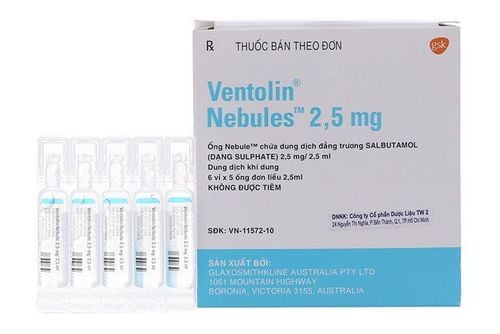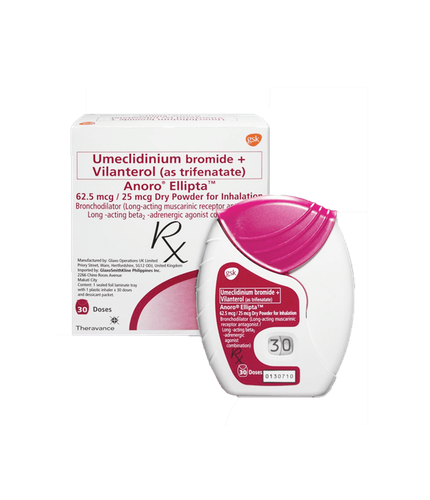This is an automatically translated article.
Bronchodilators are essential medicines to treat patients with conditions that have bronchospasm such as asthma or chronic obstructive pulmonary disease (COPD). However, when taking this drug can also cause many side effects and affect many other diseases. So what are the side effects of bronchodilators?
1. What are the effects of bronchodilators?
Bronchodilators are drugs that increase the size of the bronchial lumen, relax bronchial smooth muscle. Used in pathologies with bronchospasm. The essential bronchodilators used to treat patients with respiratory disorders are asthma (bronchial asthma) and chronic obstructive pulmonary disease (COPD). In asthma, the narrowing of the airways is caused by an inflammatory process in the bronchi caused by an overreaction to a stimulus that causes bronchoconstriction. Chronic obstructive pulmonary disease (COPD) is characterized by obstruction of ventilation or airflow limitation in the respiratory system. In the severe stage of COPD, the bronchial lumen is greatly constricted, the bronchial mucosa is inflamed, leading to increased obstruction. increased, making it very difficult for the patient to breathe. Both of these respiratory disorders are associated with inflammation and bronchoconstriction.
Therefore, one of the basic medications used to treat these two conditions is a bronchodilator, to help relieve bronchospasm and narrowing. However, when taking bronchodilators take special control, because it can cause side effects.
Also, another myth to keep in mind is that bronchodilators are not medications for shortness of breath. It only relieves shortness of breath in cases of bronchospasm, there are many other most common causes of shortness of breath such as heart failure, which if taken with bronchodilators also makes heart failure worse.
2. Bronchodilators
Bronchodilators can dilate bronchi by different mechanisms. Therefore, people divide bronchodilators into 3 different groups, including:
Beta-2 agonist group Beta 2 agonists are drugs that stimulate beta receptors of the adrenergic system in the airways. This medication helps to dilate the bronchi, thereby helping the smooth muscles around the airways relax, thereby increasing the flow of air in and out of the lungs to limit and improve breathing difficulties.
Beta 2 agonists are divided into two groups: short-acting drugs and long-acting drugs. Commonly used short-acting beta-2 agonists, such as fenoterol, salbutamol, and terbutaline, can relieve symptoms quickly, but only have a short-term effect. In addition to orally, this type can be used as an inhaled form, which is highly effective in cases where symptoms come on quickly and are severe. Long-acting beta-2 agonists such as salmeterol, bambuterol, formoterol. After taking it usually takes more than 1 hour to take effect, but the effect of the drug lasts up to more than 12 hours. Therefore, this drug can be used daily for the purpose of stopping bronchospasms and this group is not recommended for emergency use.
Anticholinergics Anticholinergics are also known as antimuscarinics. Anticholinergic drugs are able to block the action of acetylcholine. Acetylcholine is a neurotransmitter in both the central nervous system and the peripheral nervous system. This substance causes the bronchi to constrict, so taking anticholinergic drugs will inhibit the activity of the neurotransmitter acetylcholine, thereby making the airways of the disease not constricted but dilated.
Xanthine derivatives Researchers do not yet know exactly how xanthine derivatives work when administered to the body. But when taking the drug also has the ability to clear the airways of the patient. The most commonly used xanthine derivative is theophylline. Theophylline is a bronchodilator and it is a long acting bronchodilator, used orally in tablet or capsule form, or by injection by direct intravenous injection for severe cases of disease, requiring quick effect. However, doctors now rarely prescribe theophylline to patients, as many people experience notable side effects when using it.
Bronchodilators are often used depending on the severity of the disease. Patients with severe bronchospasm or poor response to bronchodilators are more likely to receive higher doses of bronchodilators, while patients with mild disease are more likely to receive the drug. lower dose bronchodilator.
In addition, which dosage form to use depends on the severity of the disease. Short-acting, rapid-acting bronchodilators are often preferred during exacerbations or when the patient presents with shortness of breath. Long-acting drugs are often preferred in cases of stable disease, helping patients feel comfortable throughout the day.
3. Bronchodilator side effects
Bronchodilators are necessary and very useful drugs in the treatment of bronchospasm, but this is also a drug that can cause unwanted effects, including:
Tachycardia: This is the most common side effect of beta-2-adrenergic and theophylline drugs. However, side effects appear at different levels and depend on each patient, some patients have experienced a rapid pulse effect, even palpitations, palpitations, but there are many patients. This effect is only transient. Because of this side effect, you need to limit the use of the drug in cases of arrhythmia, cardiovascular disease, hyperthyroidism... Hypokalemia: Hypokalemia may be encountered when taking bronchodilator drugs. beta 2 enhancement of the adrenergic system. The risk of hypokalemia is increased and may be aggravated when patients require systemic corticosteroids to control symptoms, requiring monitoring. Trembling hands and feet: This is a common side effect in some patients who need to take beta 2 adrenergic agonists, some patients have a lot of tremors, especially hand tremors, but many patients don't see it. hand tremors appear. The tremor usually goes away as soon as the medication is stopped. Poisoning: This is a condition where doses are higher than recommended. This is a particularly serious side effect, which is more likely to occur when theophylline is taken, because the toxic and therapeutic doses of theophylline are quite close. Clinical manifestations of theophylline toxicity include: anxiety, irritability, nausea and vomiting, palpitations, tachycardia. In addition, this drug should not be used with macrolide antibiotics because of the increased risk of torsades de pointes. Cramps: This may occur in patients taking beta-2 adrenergic blockers. Some patients notice signs of cramps, muscle pain, even stopping the medication. However, this side effect is not harmful to the patient, but care should be taken when swimming to avoid accidents in the water. Other side effects of xanthine derivatives include seizures, headache, and fatigue. Thus, the use of bronchodilators is quite complicated, when using bronchodilators, patients need to be specially controlled by doctors. Patients need to see a doctor and take the medicine exactly as prescribed by the doctor. In addition, it is necessary to be aware of abnormalities that occur during drug use and notify the doctor for timely treatment.
Follow Vinmec International General Hospital website to get more health, nutrition and beauty information to protect the health of yourself and your loved ones in your family.
Please dial HOTLINE for more information or register for an appointment HERE. Download MyVinmec app to make appointments faster and to manage your bookings easily.













